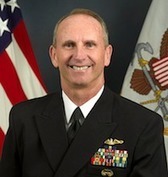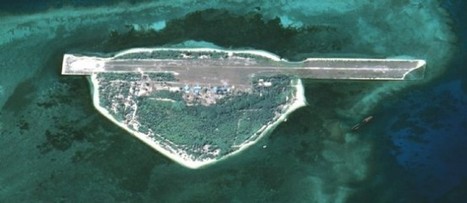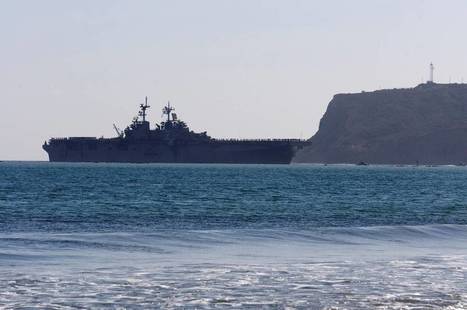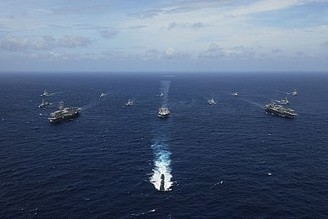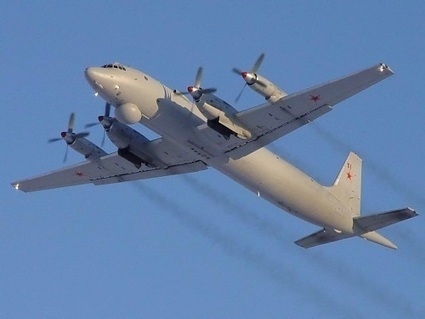 Your new post is loading...

|
Scooped by
Patrick H.
|
Depuis la visite du Président Obama à Darwin en 2011, les relations militaires américano-australiennes ne cessent de s’étoffer. En témoignent les commandes militaires auprès de Washington, telles que 58 F-35 supplémentaires ou encore huit avions de surveillance maritime P-8A Poseidon, rendues possibles par l’accroissement du budget de la Défense australien, mais aussi l’augmentation de la cadence des exercices d’entraînement impliquant les deux pays. L’Australie offre un terrain idéal pour les exercices complexes, notamment aériens, en raison d’une faible densité démographique et d’un niveau de régulation moindre qu’en Amérique du Nord. Darwin est ainsi le théâtre de “Pitch Black”, le plus grand exercice multilatéral organisé par l’armée de l’Air australienne, qui a lieu tous les deux ans et qui a réuni, en août dernier, plus de 2 300 personnels de sept armées de l’Air différentes, dont Singapour, la Thaïlande (qui inaugurait ses Gripen), la Nouvelle-Zélande, mais aussi la France (avec notamment un CN-235 venu de Nouvelle-Calédonie) et, pour la première fois, les EAU. Bilan : 110 aéronefs, 1 300 missions. Darwin accueillera également, à terme, 2 500 US Marines – une présence rotationnelle de six mois passée de 200 à 1 100 Marines entre 2012 et 2014 – et est propice à la tenue d’exercices amphibies. La présence de l’US Navy pourrait prochainement être renforcée par le déploiement supplémentaire – provisoire ou permanent – de navires destinés à soutenir une MAGT (Marine Air Ground Task Force). Savoir si ce déploiement s’inscrirait dans le même esprit que les accords de pré-positionnement de forces liant actuellement les Etats-Unis à des pays comme l’Italie, Bahreïn ou encore le Japon, et identifier le champ des possibles en matière de coopération navale bilatérale font actuellement l’objet d’une étude et de discussions entre les deux forces armées. C’est ce qu’a expliqué l’“US Chief of Naval Operations” (CNO), à savoir le commandant des opérations navales de la Marine américaine, l’amiral Jonathan Greenert, dans un discours prononcé récemment à Canberra. Il a visité les infrastructures portuaires à Darwin, afin d’évaluer les capacités d’accueil pour un navire amphibie de grande taille et des porte-hélicoptères susceptibles de constituer un “Amphibious Ready Group”. Le port de Perth pourrait accueillir d’autres navires américains allant du porte-avions au sous-marin. Alors que 60 % des forces navales américaines devraient être déployées en Asie-Pacifique à l’horizon 2020, ce renforcement est d’autant plus naturel que les élongations pénalisant jusqu’à présent l’Australie sont en partie compensées par les nouvelles capacités aéroportées dont disposent les Américains, et plus particulièrement le Marine Corps. En plus d’une aire d’entraînement incomparable (similaire à Djibouti pour les forces françaises), l’avantage d’une présence militaire américaine plus marquée en Australie est triple : elle renforce les capacités régionales de projection et de dissuasion dans la région, elle heurte moins directement les susceptibilités chinoises, en raison de son éloignement, et stimule le développement économique du pays. D’après certaines sources, en ce qui concerne Darwin, les forces armées américaines contribuent, avec un investissement actuel de 1,8 milliard de dollars australiens par an, à 10 % du produit intérieur brut des territoires du nord de l’Australie.

|
Scooped by
Patrick H.
|
Key Points - USS Fort Worth, the US Navy's third Littoral Combat Ship, arrived in Singapore's Changi Naval Base on 29 December for a 16-month deployment in the Asia-Pacific region
- Fort Worth will trial a number of new concepts and capabilities, including a four-month crew rotation and a composite rotary aviation squadron with an MQ-8B Fire Scout unmanned aerial vehicle
The US Navy's (USN's) Littoral Combat Ship (LCS) USS Fort Worth docked at Singapore's Changi Naval Base on 29 December to start a 16-month rotational deployment in the Asia-Pacific region. Fort Worth , which left its homeport of San Diego, California, on 17 November, arrived in Singapore after making its first Southeast Asian port call in Jakarta on 22 December. It had earlier transited the Pacific Ocean, where it conducted a range of surface operations including underway and vertical replenishment with the USNS Wally Schirra , as well as flight exercises with its embarked MQ-8B Fire Scout unmanned aerial vehicle (UAV). The USN's top officials in Singapore - Rear Admiral Charles Williams, Commander, Logistics Group Western Pacific (COMLOG WESTPAC) and Combined Task Force (CTF) 73, and Captain Fred Kacher, commodore of Destroyer Squadron (DESRON) Seven - told IHS Jane's during a briefing on 19 December that Fort Worth 's arrival signals the beginning of a continuous LCS presence in the region, building on what the navy considers to be USS Freedom's successful 10-month deployment in 2013, which was seen as a proof of concept for LCS operations. Up to four LCS vessels are expected to be routinely based in Singapore by 2017. A key feature of Fort Worth 's deployment will be the validation of the USN's new '3-2-1' manning concept, designed specifically for the LCS - three rotating crew complements that operate two ships, with one vessel continuously forward deployed - which prescribes crew swaps in four-month intervals in order to reduce fatigue for the 16-month stint and maintain a persistent presence in the area of operations. Freedom , in contrast, conducted only a single crew swap during its deployment. Besides its BAE Systems 57 mm main gun and Raytheon RIM-116 21-cell rolling airframe missile (RAM) launcher, Fort Worth is fitted with the surface warfare (SuW) mission package for its deployment, which comprises two maritime security boarding teams with two accompanying 11 m rigid-hull inflatable boats (RHIBs), and two Mk 46 Mod 2 Bushmaster 30 mm guns. The vessel also embarks an aviation detachment from Helicopter Maritime Squadron (HSM) 35, which is equipped with one Sikorsky MH-60R Seahawk helicopter and one Northrop Grumman MQ-8B UAV.

|
Scooped by
Patrick H.
|
Pour affirmer sa souveraineté sur l'archipel disputé Spratly, Pékin crée des îlots artificiels, déclenchant la colère impuissante de Washington. Les îles poussent comme des champignons en mer de Chine du Sud. Pour affirmer sa souveraineté sur l'archipel disputé Spratly, Pékin crée des îlots artificiels, à grands coups de remblais, déclenchant la colère impuissante de Washington. Depuis trois mois, l'empire du Milieu transforme discrètement un récif en une île artificielle capable d'accueillir une base aérienne, révèlent de nouvelles images satellites analysées par les spécialistes de IHS Jane's Defence. Fiery Cross Reef était à l'origine un simple affleurement de rochers à la surface de l'eau. Grâce à l'apport de milliers de tonnes de remblais venues de la terre ferme, ce récif fait désormais 3 kilomètres de long et 300 mètres de large. Une surface suffisante pour accueillir une base aérienne et navale avancée dans cet archipel réclamé également par le Vietnam, les Philippines, la Malaisie et Taiwan, sous le regard préoccupé des États-Unis. Un rapport présenté par le Congrès américain la semaine dernière a également pointé du doigt l'expansion territoriale chinoise dans cette zone qui serait riche en matières premières. Cette année, la Chine a déployé un gigantesque puits de forage en haute mer, déclenchant une passe d'armes tendue avec le Vietnam. Ce projet est le plus important des quatre îles artificielles en cours de construction depuis 2013 par Pékin, affirment les spécialistes de Jane's Defence. Il doit permettre à l'Armée populaire de libération (APL) de renforcer ses positions face aux forces aériennes rivales qui possèdent toutes des aéroports dans la région. Pékin réclame la souveraineté sur la mer de Chine méridionale au nom de l'histoire. Mais ces eaux sont relativement éloignées de ses côtes, par rapport à ses rivaux, et étirent ses lignes de communication depuis sa base méridionale de l'île de Hainan. Lire l'intégralité de l'article : http://www.lepoint.fr/monde/la-chine-construit-une-ile-porte-avions-24-11-2014-1883882_24.php

|
Scooped by
Patrick H.
|
Twenty-three nations, 47 ships, six submarines, more than 200 aircraft and 25,000 personnel will participate in the biennial Rim of the Pacific (RIMPAC) exercise scheduled June 26 to Aug. 1, in and around the Hawaiian Islands.
The world's largest international maritime exercise, RIMPAC provides a unique training opportunity that helps participants foster and sustain the cooperative relationships that are critical to ensuring the safety of sea lanes and security on the world's oceans. RIMPAC 2014 is the 24th exercise in the series that began in 1971.
Hosted by U.S. Pacific Fleet, RIMPAC 2014 will be led by U.S. Vice Adm. Kenneth Floyd, commander of the U.S. Third Fleet (C3F), who will serve as the Combined Task Force (CTF) Commander. Royal Australian Navy Rear Adm. Simon Cullen will serve as deputy commander of the CTF, and Japan Maritime Self Defense Force Rear Adm. Yasuki Nakahata as the vice commander. Other key leaders of the multinational force will include Rear Adm. Gilles Couturier of the Royal Canadian Navy, who will command the maritime component, Air Commodore Chris Westwood of the Royal Australian Air Force, who will command the air component, and Marine Corps Maj. Gen. Richard Simcock, who will command the land component. RIMPAC 2014 will also include a special operations component for the first time, to be led by U.S. Navy Capt. William Stevens.
Two nations, Brunei and the People's Republic of China, will participate in RIMPAC for the first time in 2014.
Also new at RIMPAC this year are two hospital ships, USNS Mercy and PLA (N) Peace Ark which will participate in the exercise.
The theme of RIMPAC 2014 is "Capable, Adaptive, Partners." The participating nations and forces will exercise a wide range of capabilities and demonstrate the inherent flexibility of maritime forces. These capabilities range from disaster relief and maritime security operations to sea control and complex warfighting. The relevant, realistic training syllabus includes amphibious operations, gunnery, missile, anti-submarine and air defense exercises as well as counter-piracy, mine clearance operations, explosive ordnance disposal and diving and salvage operations.
This year's exercise includes forces from Australia, Brunei, Canada, Chile, Colombia, France, India, Indonesia, Japan, Malaysia, Mexico, Netherlands, New Zealand, Norway, People's Republic of China, Peru, the Republic of Korea, the Republic of the Philippines, Singapore, Thailand, Tonga, the United Kingdom and the United States.
|

|
Scooped by
Patrick H.
|
The United States is mulling a plan to regularly dock warships in Australia, the navy’s top commander said yesterday according to The Wall Street Journal. During a visit to Australia to inspect port facilities, U.S. Chief of Navy Operations Jonathan Greenert said that basing U.S. ships there was one of several measures being considered by Washington as part of a broader look into how to expand maritime cooperation between the two allies. “We’re doing a study…to see what might be feasible for naval cooperation in and around Australia, which might include basing ships,” The Journal quoted Greenert as saying at a university lecture. According to The Journal, Greenert revealed that the United States had been looking at various bases and ports and has identified warships to form an Amphibious Ready Group to support a Marine Air Ground Task Force, including a large amphibious assault carrier and two smaller helicopter carriers. Their regular presence could require the expansion of existing port facilities. Greenert was careful to point out that such plans were very much “in the early stages” and that any measure would consider how it fits “into the two nations’ strategic desires.” A spokesman for Greenert also later clarified that any such enhanced naval presence would be rotational rather than permanent, which The Journal included in an updated version of its initial report. In a speech in Hawaii before heading to Australia, Greenert had said he was going to examine the country’s ports “to see what that’s like” as the navy expects to deploy amphibious ships by the end of the decade. The growing U.S. presence would come amid ongoing efforts to eventually station 2,500 marines in Darwin, which were initially announced by U.S. President Barack Obama in November 2011 as part of his administration’s ‘rebalance’ to the Asia-Pacific. According to The Journal, Greenert also said that he supported the expansion of the annual Malabar exercises involving the United States and India to include Japan and Australia. Washington and New Delhi had both reiterated their commitment to “upgrading” the exercises during Obama’s meeting with Prime Minister Narendra Modi last month, but China has previously balked at past attempts to expand them. “Multilateral works best,” Greenert said. “It’s an amazing deterrent. If somebody figures they are going to take on one of you, there is some likelihood they may be taking on all four of you. That tends to hold folks back,” he added.

|
Scooped by
Patrick H.
|
The Western Military District issued a gushing press release today in which it reported that the Russian Navy Northern Fleet (no longer part of the Western Military District as of December 1, 2014) had won 13 of the 24 Russian Navy CINC trophies awarded this year. Singled out in the press release were three submarine commanding officers: Captain 1st Rank Dmitriy Ivanov (Sierra II-class nuclear-powered fast-attack submarine "Nizhniy Novgorod"), Captain 2nd Rank Denis Semyanskikh (Delta IV-class nuclear-powered ballistic missile submarine "Yekaterinburg" - his crew was on "Tula" for the May 2014 launch of a single SS-N-23/Skiff ballistic missile), and Captain 2nd Rank Sergey Pirozhenko (Kilo-class diesel submarine "Kaluga").
One might think that the Pacific Fleet, which hosted this year's operational-strategic exercise VOSTOK, would have surpassed all other fleets or at least tied for first place. When your fleet's in poor shape, however, it's hard to win many.
Looking at just the Pacific Fleet's operational nuclear submarine force, there are only two Delta III-class ballistic missile submarines and two Oscar II-class cruise missile submarines capable of performing their wartime missions. The fleet has no operational Akula I-class fast-attack submarines. So, where are the rest? - Delta III: Both "Podolsk" and "Svyatoy Georgiy Pobedonosets" turned 35 years old this year. These two have served well past their design service lives because Dolgorukiy-class nuclear-powered ballistic missile submarines "Aleksandr Nevskiy" and "Vladimir Monomakh" failed to transfer - in 2014, 2013, 2012, etc. - to the Pacific Fleet despite the many proclamations by defense minister Sergey Shoygu, his predecessor, and all of their subordinates. Will Delta III "Ryazan" ever return from long-term maintenance? After transferring from the Northern Fleet to the Pacific Fleet in 2008, "Ryazan" only served three years before heading to Zvezda Far East Shipyard (Bolshoy Kamen) in 2011 for repairs. The submarine has been there so long the MOD had to sign a second contract in 2013 to cover the repairs that should have been completed under the first contract.
- Oscar II: "Omsk" and "Tver" are the fleet's only two operational General Purpose Force nuclear-powered submarines, and both of them won trophies this year. "Omsk" just returned from somewhere in the past few days as suggested by a MOD tweet today. "Krasnoyarsk" is being scrapped. "Irkutsk" is at Zvezda Far East Shipyard undergoing upgrades to carry the Kalibr-family of missiles. It won't return to service until at least December 2017. "Chelyabinsk" was just delivered to Zvezda Far East Shipyard this year, and no major components have been ordered for its Kalibr upgrade. Finally, "Tomsk" transferred to Zvezda Far East Shipyard in 2008 for a simple service life extension repair period, but it has yet to return to operational service.
- Akula I: "Akula" and "Barnaul" have been scrapped. "Kashalot" has been stuck at Amur Shipyard since 2003; its fate is unknown. "Bratsk" and "Samara" were ferried on board the Dutch-flagged heavy-lift ship "Transshelf" this summer from Rybachiy to Zvezdochka Ship Repair Center (Severodvinsk) for Kalibr upgrades. "Kuzbass" and "Magadan" have been at Zvezda Far East Shipyard since at least 2009 and 2012, respectively; their fates also remain unclear.
In other words, of the 13 nuclear-powered submarines still on the Pacific Fleet's books, only ~31% are operational.

|
Scooped by
Patrick H.
|
The first modernized anti-IL-38N Pacific Fleet (PF) will receive in 2015, according to TASS referring to the press service chief of the Pacific Fleet Captain First Rank Roman Martov.
"Next year, the Pacific Fleet ASW aircraft waits for upgraded IL-38N, which will be the first sign of re naval aviation in the Pacific," - he said. Upgraded anti-IL-38N development of JSC "Aviation Complex named after SV Ilyushin "(JSC" IL ") differs from the basic model of the new search and targeting system" Novella-P-38 ", which significantly expanded the scope of tasks solved by plane and its combat capabilities. The first such aircraft of "IL" Narrated by the Russian Navy in July of this year. Total contract provides serial modernization of five aircraft I-38 to the level of IL-38N.
|



 Your new post is loading...
Your new post is loading...

